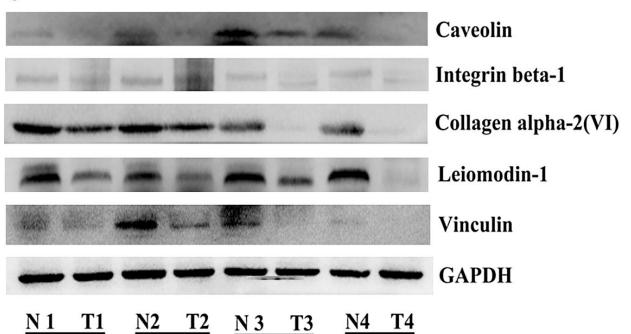Collagen VI alpha 2 Antibody - #DF3552
| Product: | Collagen VI alpha 2 Antibody |
| Catalog: | DF3552 |
| Description: | Rabbit polyclonal antibody to Collagen VI alpha 2 |
| Application: | WB IHC IF/ICC |
| Cited expt.: | WB |
| Reactivity: | Human, Rat |
| Prediction: | Pig, Bovine, Horse, Sheep, Rabbit, Dog |
| Mol.Wt.: | 109 KD; 109kD(Calculated). |
| Uniprot: | P12110 |
| RRID: | AB_2835925 |
Related Downloads
Protocols
Product Info
*The optimal dilutions should be determined by the end user. For optimal experimental results, antibody reuse is not recommended.
*Tips:
WB: For western blot detection of denatured protein samples. IHC: For immunohistochemical detection of paraffin sections (IHC-p) or frozen sections (IHC-f) of tissue samples. IF/ICC: For immunofluorescence detection of cell samples. ELISA(peptide): For ELISA detection of antigenic peptide.
Cite Format: Affinity Biosciences Cat# DF3552, RRID:AB_2835925.
Fold/Unfold
CO6A2_HUMAN; COL6A2; Collagen alpha 2(VI) chain; Collagen alpha-2(VI) chain; collagen type VI alpha 2; Collagen VI alpha 2 polypeptide; human mRNA for collagen VI alpha 2 C terminal globular domain; PP3610;
Immunogens
A synthesized peptide derived from human Collagen VI alpha 2, corresponding to a region within the internal amino acids.
- P12110 CO6A2_HUMAN:
- Protein BLAST With
- NCBI/
- ExPASy/
- Uniprot
MLQGTCSVLLLWGILGAIQAQQQEVISPDTTERNNNCPEKTDCPIHVYFVLDTSESVTMQSPTDILLFHMKQFVPQFISQLQNEFYLDQVALSWRYGGLHFSDQVEVFSPPGSDRASFIKNLQGISSFRRGTFTDCALANMTEQIRQDRSKGTVHFAVVITDGHVTGSPCGGIKLQAERAREEGIRLFAVAPNQNLKEQGLRDIASTPHELYRNDYATMLPDSTEIDQDTINRIIKVMKHEAYGECYKVSCLEIPGPSGPKGYRGQKGAKGNMGEPGEPGQKGRQGDPGIEGPIGFPGPKGVPGFKGEKGEFGADGRKGAPGLAGKNGTDGQKGKLGRIGPPGCKGDPGNRGPDGYPGEAGSPGERGDQGGKGDPGRPGRRGPPGEIGAKGSKGYQGNSGAPGSPGVKGAKGGPGPRGPKGEPGRRGDPGTKGSPGSDGPKGEKGDPGPEGPRGLAGEVGNKGAKGDRGLPGPRGPQGALGEPGKQGSRGDPGDAGPRGDSGQPGPKGDPGRPGFSYPGPRGAPGEKGEPGPRGPEGGRGDFGLKGEPGRKGEKGEPADPGPPGEPGPRGPRGVPGPEGEPGPPGDPGLTECDVMTYVRETCGCCDCEKRCGALDVVFVIDSSESIGYTNFTLEKNFVINVVNRLGAIAKDPKSETGTRVGVVQYSHEGTFEAIQLDDERIDSLSSFKEAVKNLEWIAGGTWTPSALKFAYDRLIKESRRQKTRVFAVVITDGRHDPRDDDLNLRALCDRDVTVTAIGIGDMFHEKHESENLYSIACDKPQQVRNMTLFSDLVAEKFIDDMEDVLCPDPQIVCPDLPCQTELSVAQCTQRPVDIVFLLDGSERLGEQNFHKARRFVEQVARRLTLARRDDDPLNARVALLQFGGPGEQQVAFPLSHNLTAIHEALETTQYLNSFSHVGAGVVHAINAIVRSPRGGARRHAELSFVFLTDGVTGNDSLHESAHSMRKQNVVPTVLALGSDVDMDVLTTLSLGDRAAVFHEKDYDSLAQPGFFDRFIRWIC
Predictions
Score>80(red) has high confidence and is suggested to be used for WB detection. *The prediction model is mainly based on the alignment of immunogen sequences, the results are for reference only, not as the basis of quality assurance.
High(score>80) Medium(80>score>50) Low(score<50) No confidence
Research Backgrounds
Collagen VI acts as a cell-binding protein.
Prolines at the third position of the tripeptide repeating unit (G-X-Y) are hydroxylated in some or all of the chains.
Secreted>Extracellular space>Extracellular matrix. Membrane>Peripheral membrane protein.
Note: Recruited on membranes by CSPG4.
Belongs to the type VI collagen family.
Research Fields
· Cellular Processes > Cellular community - eukaryotes > Focal adhesion. (View pathway)
· Environmental Information Processing > Signal transduction > PI3K-Akt signaling pathway. (View pathway)
· Environmental Information Processing > Signaling molecules and interaction > ECM-receptor interaction. (View pathway)
· Human Diseases > Infectious diseases: Viral > Human papillomavirus infection.
· Organismal Systems > Digestive system > Protein digestion and absorption.
References
Application: WB Species: human Sample: ESCC tissues
Restrictive clause
Affinity Biosciences tests all products strictly. Citations are provided as a resource for additional applications that have not been validated by Affinity Biosciences. Please choose the appropriate format for each application and consult Materials and Methods sections for additional details about the use of any product in these publications.
For Research Use Only.
Not for use in diagnostic or therapeutic procedures. Not for resale. Not for distribution without written consent. Affinity Biosciences will not be held responsible for patent infringement or other violations that may occur with the use of our products. Affinity Biosciences, Affinity Biosciences Logo and all other trademarks are the property of Affinity Biosciences LTD.


